How to bring back dormant subscribers and keep them active
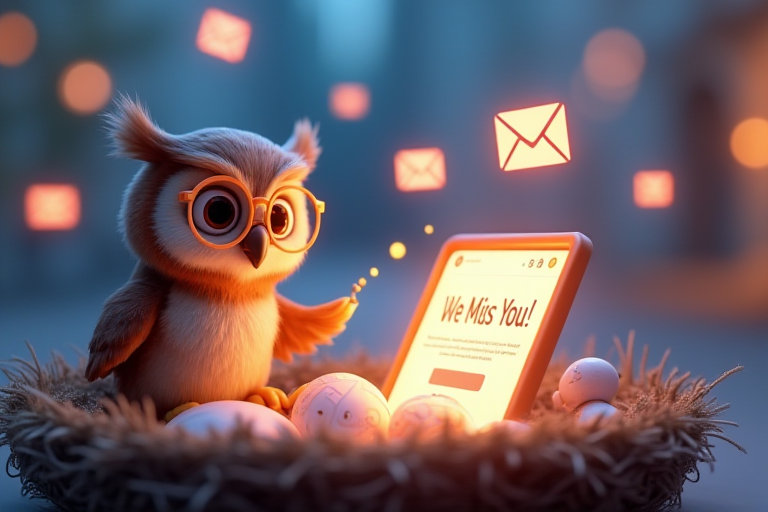
- What is retention in email marketing?
- What metrics will help evaluate retention?
- The main reasons why subscribers become “dormant”
- How to keep subscribers in the active phase?
- Strategies for bringing back inactive subscribers
- Why is it important to bring back “dormant” subscribers?
- Basic strategies for bringing back inactive subscribers
- Understanding the reason for inactivity
- A series of “win-back” letters
- Gamification and interactivity
- Using retargeting
- Base cleaning and reactivation – when and how to do it
- Why can’t you ignore database cleaning?
- The main risks of working with “dead” subscribers
- How to determine that a subscriber is “dead”?
- Reactivation before deletion
- How to properly clean the base?
- Should you be afraid of losing subscribers?
- Examples of recovery letters
- A simple and friendly letter: “We miss you”
- Letter with an exclusive offer
- Playful and interactive letter
- Letter-“ultimatum”: “This is the last chance!”
1. What is retention in email marketing?
When a business starts actively developing email marketing, one of the main goals is to consistently increase the number of subscribers. But attracting new people is only part of the job. The most important thing is to keep them, make them active participants in your email community, and reduce the number of “dormant” subscribers.
Retention in the context of email marketing is a strategy for interacting with subscribers that aims to ensure that they remain active, open emails, interact with content, and do not unsubscribe.
According to statistics, up to 70% of subscribers become inactive within 6 months of subscribing . This means that even if you have a large base, the effectiveness of your mailings may be low due to a high proportion of “dormant” contacts.
Why is this important?
- Your base may be large, but if most people don’t open your emails, its effectiveness will be zero.
- Poor activity negatively affects the sender’s reputation : email services (Gmail, Outlook) rate your mailing as “junk”, which increases the risk of it ending up in spam.
- Losing followers means losing potential customers . If you don’t work on retention, you’re missing out on monetizing your base.
Example:Company A had a subscriber base of 100,000 but an open rate of 8%. They decided to implement a retention strategy, developed a series of personalized email campaigns, and after 3 months, they raised their open rate to 25%, which also increased sales by 40%.
What metrics will help evaluate retention?
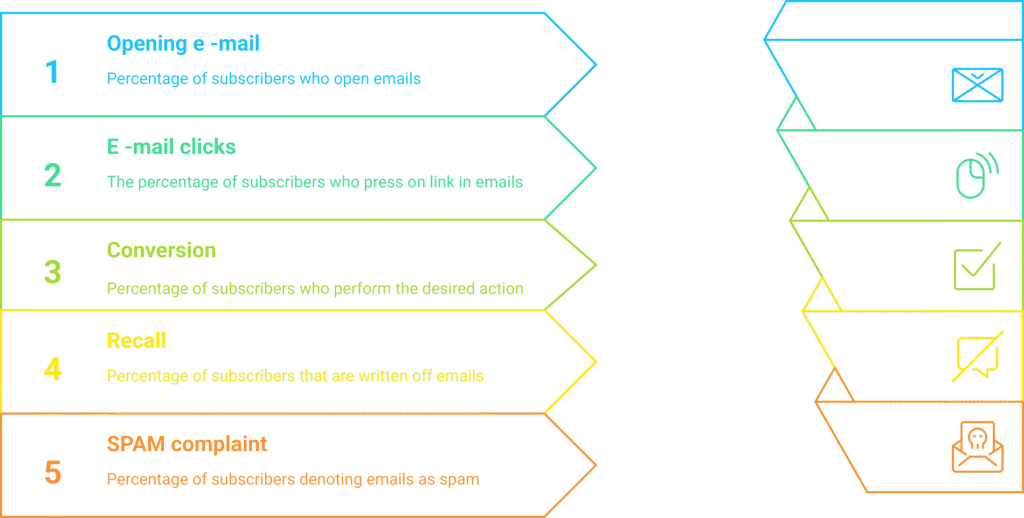
To understand how well you are retaining followers, it is worth regularly analyzing the following metrics:
✅ Open Rate (percentage of openings) – are your emails being opened?
✅ Click-Through Rate (CTR) – are links in emails being clicked?
✅ Conversion Rate – do subscribers take targeted actions (purchases, registrations)?
✅ Churn Rate (unsubscribe rate) – how many people unsubscribe or become inactive?
✅ Spam Complaints – do subscribers complain about your emails?
The higher your Open Rate and CTR, the more active subscribers you have. If your Open Rate is dropping and your unsubscribes are increasing, you need to change your retention strategy.
The main reasons why subscribers become “dormant”
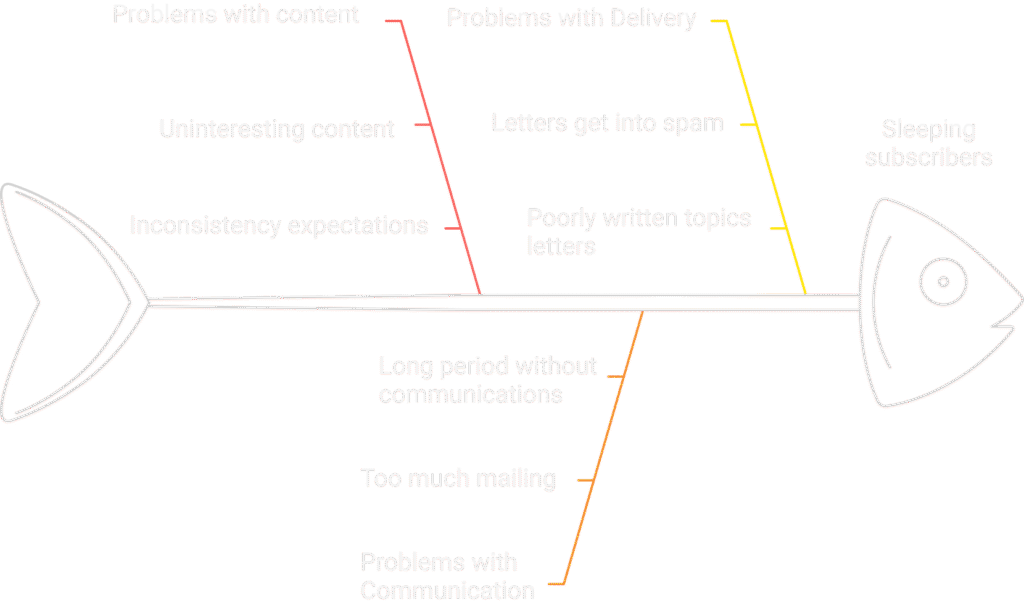
To effectively retain your audience, you need to understand what makes people ignore your emails or completely disappear from your database. Here are the main reasons:
- Too many newsletters – if you bombard subscribers with emails every day, they will quickly get tired.
- Uninteresting or irrelevant content — if your emails don’t provide value, people will stop opening them.
- Misalignment of expectations – if people signed up for helpful tips but only receive ads, it will annoy them.
- Poorly written email subjects — if the subject doesn’t attract attention, the email simply won’t be opened.
- Delivery issues — if your emails often end up in spam, people won’t even know you’re writing to them.
- A long period of no communication – if a subscriber doesn’t receive emails from you for months, they may simply forget they ever subscribed.
Example:Company B was sending out emails 4 times a week. After analyzing the metrics, it turned out that the Open Rate was dropping and the number of unsubscribes was increasing. They reduced the frequency to 1 time per week and added more personalized content. As a result, the Open Rate increased by 15% and the unsubscribe rate decreased by 30%.
How to keep subscribers in the active phase?
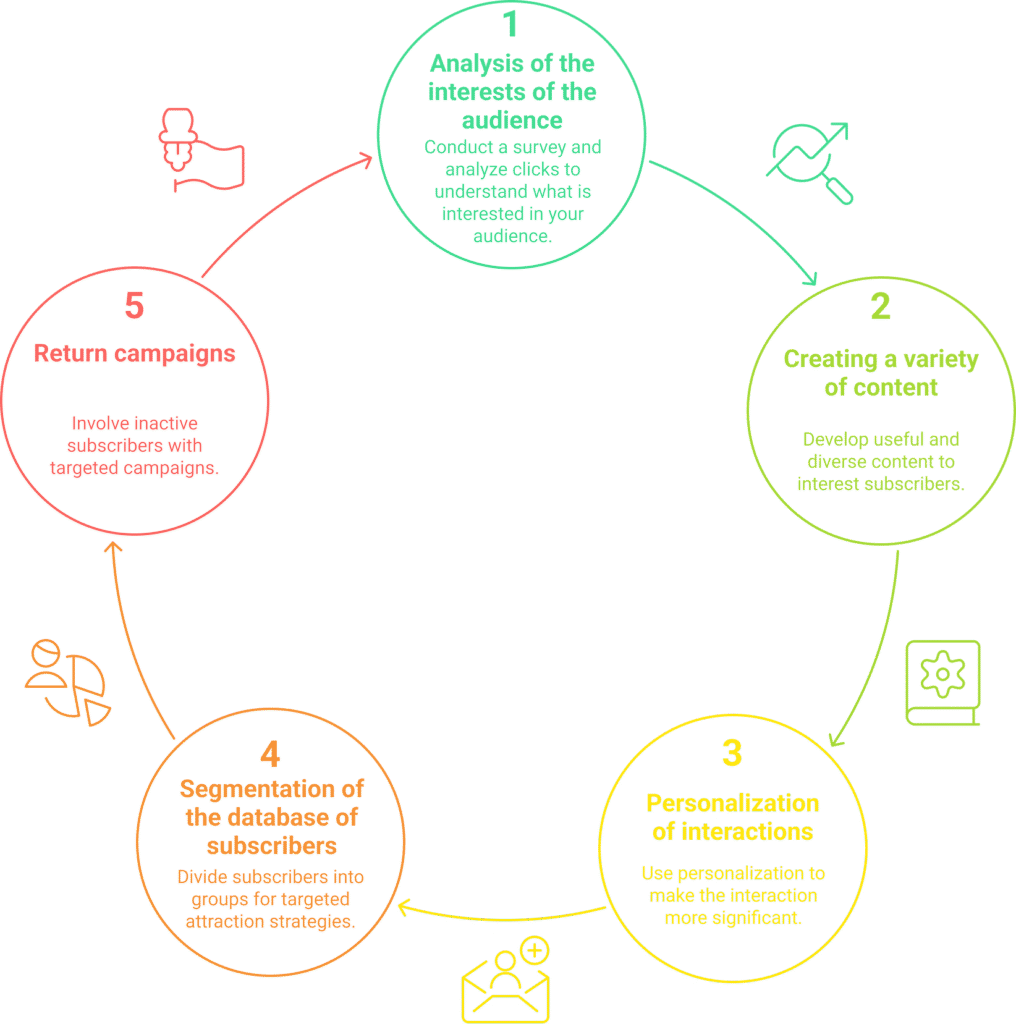
To prevent people from falling asleep, you need to:
✔️ Regularly check what interests your audience – conduct surveys, analyze clicks and reactions.
✔️ Create useful and diverse content – not only promotions and sales, but also useful tips, cases, insights.
✔️ Use personalization – address by name, send emails based on the subscriber’s previous actions.
✔️ Segment – not all subscribers are the same, some are interested in new products, while others are only waiting for discounts.
✔️ Don’t forget about “win-back” campaigns – special series of emails to wake up inactive subscribers.
Conclusion
Retention у email-маркетингу — це не просто відправка листів, а системна робота над тим, щоб підписники залишалися залученими. Якщо ви вчасно аналізуєте показники та тестуєте різні стратегії, ви зможете підтримувати високий рівень активності в базі та зменшувати кількість “сплячих” контактів.
2. Strategies for bringing back inactive subscribers
If your subscribers haven’t opened your emails for a long time, it doesn’t mean they’ve lost interest forever. A properly designed strategy for returning inactive subscribers can re-engage a portion of your base in active interaction.
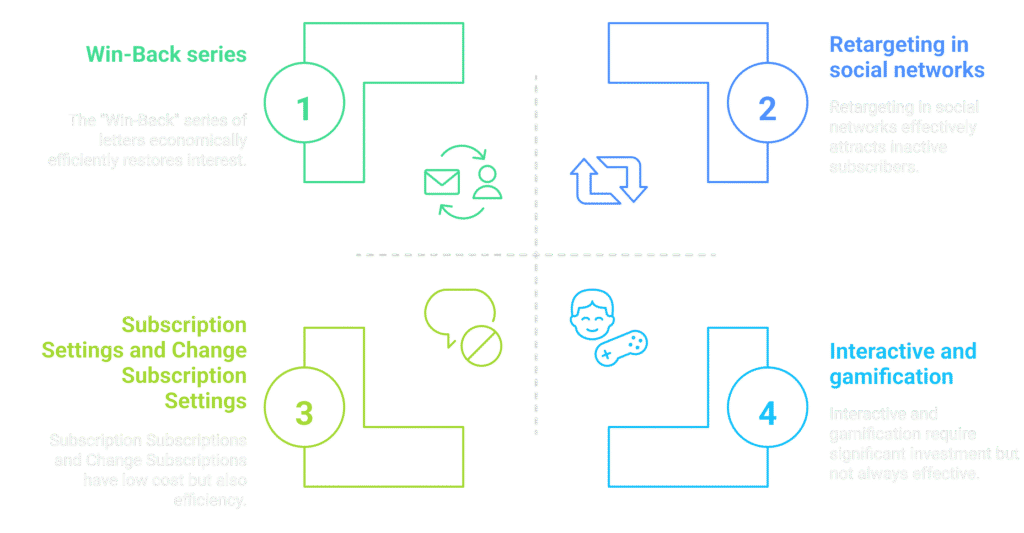
Why is it important to bring back “dormant” subscribers?
Most companies focus on constantly growing their base, forgetting about those who are already there but are not interacting. And in vain:
✅ Reengaging is cheaper than acquiring a new subscriber . You already have an email, you don’t need to spend a budget on advertising or other engagement channels.
✅ This improves overall email delivery performance . The more subscribers open your emails and click on links, the better reputation your domain gets from email services.
✅ Returning subscribers can become more loyal . If they return to interact, it means that your content is really interesting to them.
But it is worth understanding that not all “dormant” subscribers are ready to return. Some of them have lost interest in your topic, and some may simply not check the email address to which they receive the newsletter. That is why it is important not to waste time in vain, but to use the right methods.
Basic strategies for bringing back inactive subscribers
1. Understanding the reason for inactivity
Before you can bring your followers back, you need to understand why they became inactive. Here are the main reasons and possible solutions:
- 📌 They are bored with your content → Try changing the presentation style, adding more interactivity, asking what they are interested in.
- 📌 You write too rarely (or vice versa – too often) → Give subscribers the opportunity to choose the frequency of receiving emails.
- 📌 Your emails are getting into spam or “Promotions” → Change the structure of the email, test different subject formats, check if you haven’t been filtered.
- 📌 Subscriber has changed their interests → Suggest updating their subscription settings to receive only relevant content.
Example:A large online store noticed that some of their subscribers hadn’t opened their emails for 6 months. They conducted a survey and found that 40% of them simply didn’t know about the ability to change the subject of their emails. After launching a campaign with interest settings, 25% of their “dormant” subscribers became active again.
2. A series of “win-back” letters
This is a series of emails that gradually bring the subscriber back to activity. It consists of several stages:
📩 First letter: “We miss you!”
- Contact the subscriber personally.
- Ask if he is still interested in your content.
- Show that you appreciate his presence in the base.
📩 Second letter: “What can we improve?”
- Suggest changing your subscription settings.
- Give the option to choose other email topics or frequency of sending.
- Add a poll or a “Stay with us” button.
📩 Third letter: “Special offer just for you”
- Use a limited-time discount, bonus, or other incentive.
- Explain why it is worth staying on the subscriber list.
📩 Fourth letter: “Farewell” (if necessary)
- If the subscriber doesn’t respond, you can send a final email: “We don’t want to lose you, but if you’re no longer interested, here’s the unsubscribe button.”
- This will help reduce the number of “dead” contacts in the database.
Example:A cosmetics brand sent a series of three “win-back” emails, reminding them about themselves, offering to change the frequency of their emails, and offering a personalized discount. As a result, 18% of subscribers started opening emails and making purchases again.
3. Gamification and interactivity
One way to regain interest is to make the process of interacting with your email newsletter exciting. These can include:
- 📊 Mini-games and quizzes : “Take the test and get a personal bonus!”.
- 🎁 Raffles and gifts : “We will choose 5 people from among those who open this letter.”
- 🤖 Chatbots in emails : an interactive element that asks the subscriber what topics they are interested in.
Example:An online English school launched an interactive test in its email newsletter “What is your English level?” Subscribers who passed the test received personalized recommendations and course suggestions. As a result, 22% of “dormant” users returned to activity.
4. Using retargeting
Not all subscribers open emails, but many engage with your brand on social media. Using Facebook Ads or Google Ads to retarget inactive subscribers can increase their engagement.
How does it work?
- You create a separate audience from the email addresses of subscribers who haven’t opened emails in a long time.
- Run ads with a reminder of your brand or with unique offers.
- Some subscribers start opening your emails again after coming into contact with advertising.
Example:A SaaS service ran an email campaign to get subscribers back, but it only yielded 5% results. They decided to run retargeting ads on the same users. This added another 12% of returning subscribers.
Let’s summarize
Bringing back dormant subscribers is a long-term strategy that requires testing and analysis. The best results are achieved by:
✔️ Win-back email series
✔️ Surveys and changing subscription settings
✔️ Interactive and gamification
✔️ Retargeting on social networks
By applying these methods, you can not only bring back subscribers, but also improve the overall effectiveness of your email newsletter.
3. Base cleaning and reactivation — when and how to do it
Cleaning your subscriber base is one of the key stages of email marketing. It helps get rid of “dead” addresses, improve email open rates, and avoid problems with email services. But when exactly should you clean your base, and how to do it correctly without losing valuable contacts?

Why can’t you ignore database cleaning?
Many companies are afraid to delete subscribers, believing that a large base = high profits. But this is not true. Inactive subscribers not only do not buy, but can also damage your reputation.
The main risks of working with “dead” subscribers:
✅ Decreased Open Rate. If you constantly send emails to those who don’t open them, email services begin to perceive your emails as uninteresting.
✅ Increasing spam complaints. Some subscribers may not even remember that they ever subscribed to your emails and will mark them as spam.
✅ Risk of getting blacklisted. If you regularly send emails to inactive or incorrect addresses, it can ruin your domain’s reputation, and your emails will start to be automatically blocked.
✅ Costs for unnecessary email addresses. Many mailing services charge the cost of mailings based on the number of contacts in the database. Why pay for those who never open your emails?
Example:An e-commerce company didn’t clean its database for two years, accumulating over 200,000 contacts. But after analysis, it turned out that only 60,000 of them open at least one email per month. After cleaning the database, the open rate increased from 12% to 32%, and clicks doubled.
How to determine that a subscriber is “dead”?
There are several criteria by which you can understand that a subscriber is not interested in your newsletters:
📌 Has not opened any emails in the last 6-12 months.
📌 Has never clicked on links in emails.
📌 His email bounces.
📌 Was previously active, but suddenly stopped opening emails.
Depending on the degree of inactivity, you can either try to reactivate the subscriber or remove them from the database.
Reactivation before deletion
Before you permanently delete subscribers, it’s a good idea to give them one last chance to come back. This is done using a reactivation series of emails .
What does a reactivation series look like?
🔹 Letter 1: “Are you staying with us?”
👉 A friendly reminder that the user is subscribed to your newsletter.
👉 The ability to change subscription settings (for example, receive fewer emails).
👉 “I want to stay on the list” or “Change settings” button.
🔹 Letter 2 (a few days later): “We have a surprise for you!”
👉 Offer a unique discount, bonus, or free stuff.
👉 This works especially well if you have an e-commerce or information product.
🔹 Letter 3 (last): “This is the last chance!”
👉 Final warning that the email will be deleted from the database.
👉 Call to action: “Stay on the list” or “Unsubscribe forever.”
If after this series the subscriber has not shown any activity, it is better to delete him.
Example:An online coding course sent a reactivation email series to 50,000 inactive subscribers. After the first email, 5% of subscribers returned, after the second, another 7%, and after the third, 3%. As a result, they managed to retain 7,500 subscribers who might otherwise have simply “frozen” in the database without taking any action.
How to properly clean the base?
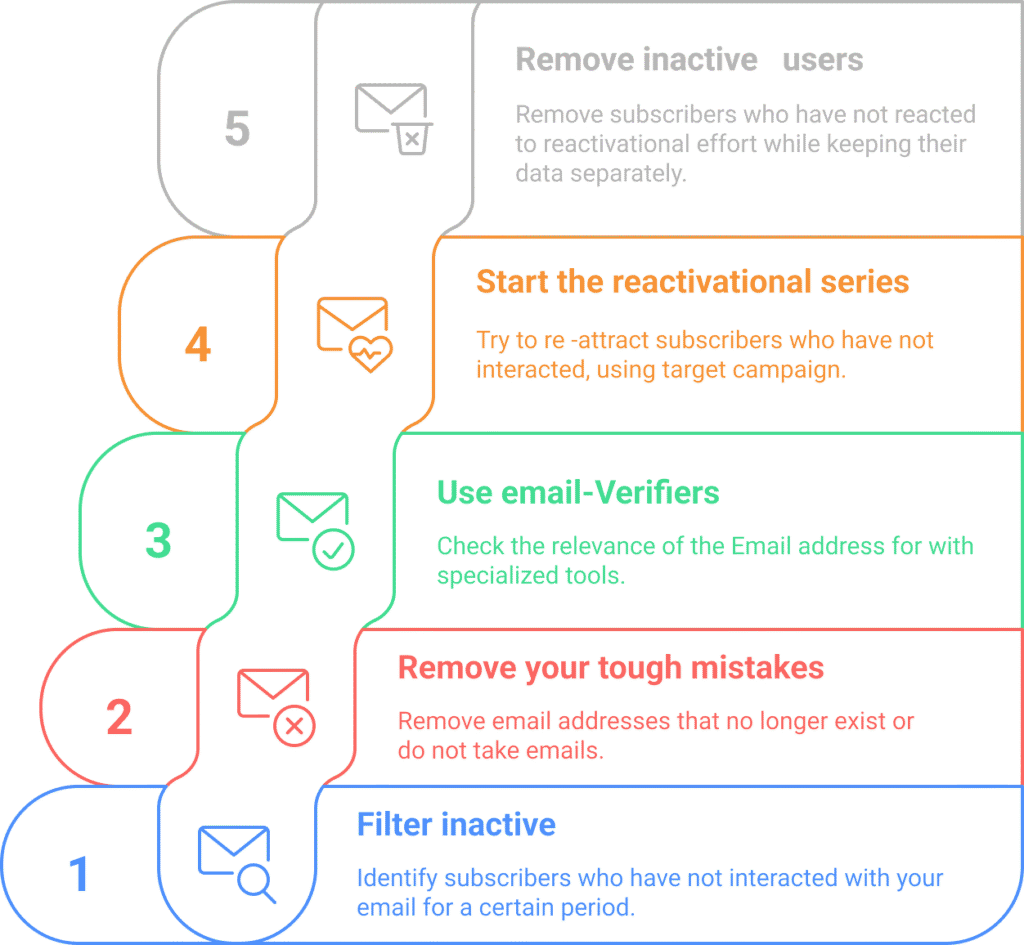
When you are sure that certain email addresses are no longer useful, it’s time to move on to deleting them.
Step 1: Filter out inactive followers
In email marketing services (Mailchimp, SendPulse, Klaviyo, HubSpot), you can create a segment with subscribers who have not opened your emails for more than 6-12 months.
Step 2: Remove hard bounces
These are email addresses that do not exist or are no longer accepting emails. They create problems for the sender’s reputation, so they should be deleted first.
Step 3: Use email verifiers
Sometimes subscribers simply change their addresses or use temporary emails. Tools like ZeroBounce or Hunter.io can help you check which emails are still valid.
Step 4: Start the reactivation series
Before deleting “warm” subscribers, try to get them back using win-back campaigns.
Step 5: Remove inactive users
If a subscriber hasn’t opened emails or responded to reactivation, it’s worth deleting them. But before that, it’s worth saving their email in a separate file – what if they come back through other channels?
Example:One SaaS service purged 30% of its base after discovering that these subscribers hadn’t opened emails in over a year. After the purge, their average open rate increased from 15% to 38%, and clicks nearly tripled.
Should you be afraid of losing subscribers?
Many companies put off cleaning their database because they are afraid of “losing” subscribers. But in reality, it will only improve your mailing list.
🚀 10,000 active subscribers are better than 100,000 “dead” ones.
📈 Cleaning the database improves the sender’s reputation and letter opening.
💰 You save money on mailing services by paying only for active users.
Regularly cleaning your database is not a loss, but an optimization. By removing inactive subscribers, you make your email marketing more effective.
Let’s summarize
Database cleaning is an important process for any email marketer. It helps increase the effectiveness of your mailings, avoid problems with spam filters, and save money.
👉 Reactivate subscribers before deleting.
👉 Delete “broken” addresses and those that have not opened emails for more than 12 months.
👉 Check the database through email verifiers.
👉 Don’t be afraid of losing contacts – this will make your mailing stronger.
4. Examples of recovery letters
Creating an effective reactivation email is an art of balancing between being persistent and being unobtrusive. The main goal is to get the subscriber back to engage, not to make them click the “Unsubscribe” button. Let’s look at successful examples of reactivation email campaigns and analyze their structure.
1. A simple and friendly letter: “We miss you”
📌 When to use:
- If the subscriber has not opened emails for 3-6 months.
- If you have a “warm” customer base that was previously active.
📩 Example of a letter:
Topic: We haven’t seen you in a while! Here’s something special 💙
Hi, [Name]!We noticed you haven’t opened our emails in a while 😢
If you are no longer interested in our content, we won’t be upset. But if you still want to stay up to date with exclusive news and offers, click the button below!
🔵 Yes, I’m staying!
And if you want to receive emails from us less often, you can adjust the frequency of your newsletter here.
See you soon!Your team [Brand]
✅ Why does it work?
- An emotional element is used (“We miss you”).
- You are offered a choice: stay or change settings.
- Minimum text, simple CTA button.
2. Letter with an exclusive offer
📌 When to use:
- If you need to bring back customers to e-commerce.
- If you have a paid product or subscription.
📩 Example of a letter:
Subject: 🎁 Special discount for you, [Name]!
Hi, [Name]!We noticed you haven’t been to [Site/Store] in a while. We miss you! So here’s something special for you:
🚀 -20% off your next purchase!
Use promo code COME_BACK20 when placing your order.
⏳ Offer valid for 48 hours only!
👉 Return and use the discount
We are waiting for you!Your team [Brand]
✅ Why does it work?
- Personalization is used (“for you, [Name]”).
- The clear benefit is an exclusive discount.
- The limited time effect (“48 hours”) encourages action.
3. Playful and interactive letter
📌 When to use:
- If your audience likes non-standard formats.
- If you have a brand with easy, friendly communication.
📩 Example of a letter:
Topic: Do you still remember us? 😜
Hey, [Name]!We’re a little worried: do you still remember who we are? 🤔
Let’s check:1️⃣ If you still want to receive our emails, click “I’m with you!”2️⃣ If you want to receive emails less often, click “Change frequency”3️⃣ If you are no longer interested in us – we are not offended, just click “Unsubscribe”
🔵 I’m with you!
By the way, we have a lot of new cool updates! Check it out here 👉 [Link]
With love, your team [Brand]
✅ Why does it work?
- An interactive format is used that encourages response.
- It doesn’t put pressure on the subscriber – there is a friendly tone.
- It is possible to change the frequency of receiving emails.
4. Letter-“ultimatum”: “This is the last chance!”
📌 When to use:
- If the subscriber has not responded to previous reactivation emails.
- If you want to reduce your inactive contact base.
📩 Example of a letter:
Subject: [Name], we are removing you from the list…
Hello, [Name]!We see that you haven’t opened our emails for a while. Maybe you’re not interested anymore? 😔
If you want to stay on the list and continue to receive exclusive offers, just click the button below:
🔵 I’m staying!
If you do not respond to this email within 3 days, we will automatically delete your email from our database.
Thank you for being with us! ❤️[Brand] Team
✅ Why does it work?
- The element “fear of missing out” is used (fear of losing access to information).
- Clear deadline – 3 days.
- The consequences are indicated – automatic deletion.
To summarize
The main goal of reactivation emails is not just to bring the subscriber back, but to do it gently, without coercion. The most effective reactivation campaigns include:
✔ Emotional connection (“We miss you”)
✔ Personalization (“[Name], we have prepared a surprise for you!”)
✔ Motivating bonus (discount, free content, exclusive access)
✔ Clear CTA (“I’m staying!”, “Change settings”, “Use discount”)
✔ Time limit (urgency effect)
Not all subscribers will come back, and that’s okay. The key is to do everything you can to give them a reason to stay.
Conclusions and final recommendations
Reengaging dormant subscribers and keeping your audience engaged is an ongoing process that requires understanding your audience, testing different approaches, and analyzing results. If your email campaign isn’t delivering the results you’re expecting, it might be time to rethink your retention and reactivation strategy.
1. Key lessons about retention and reactivation
🔹 Retention is more important than acquisition
A simple marketing law: it is cheaper and more effective to retain a customer than to find a new one. If you focus only on attracting new subscribers, and the old ones simply “die” – the base gradually degrades.
🔹 Segmentation is the key to success
You can’t send the same emails to the entire base. Active subscribers want to receive more, inactive ones want to receive less. Use dynamic segments for different categories of subscribers, and communication will become many times more effective.
🔹 Always leave a choice
Reactivation emails work best when the person has a choice: stay, change the frequency of receiving emails, or unsubscribe. When you show respect for their choice, it builds trust.
🔹 Personalization is the key to engagement
“Hi, [Name]!” is the bare minimum that every email should have. But true personalization is when you understand the subscriber’s behavior:
✔ What did they buy?
✔ What topics did they open?
✔ How often did they interact with the content?
🔹 Cleaning the database is a necessity, not a loss
Many companies are afraid to delete inactive subscribers, thinking that it will reduce their audience. But in reality, “dead” subscribers only harm the deliverability of emails. Regular cleaning of the database is a sign of healthy email marketing.
🔹 Don’t be afraid to be bold in your recovery campaigns
Sometimes you just need to say straight out: “We’re removing you from the list ,” and it works. Use different approaches: from gentle reminders to tough “ultimatums.”
2. What to do next?
✅ Check your base.
Find out how many “dormant” subscribers you have and divide them into groups by period of inactivity (3, 6, 12 months).
✅ Develop a series of reactivation emails
Don’t send one email and expect a miracle. Implement an automated series of reactivation emails (e.g., 3 emails with an interval of 5-7 days).
✅ Test and analyze
A/B testing of topics, content, and CTA will help you find the most effective format.
✅ Set up automatic database cleaning.
If a subscriber has not responded to all reactivation emails, automatically remove them from the database or transfer them to the “cold” segment.
✅ Don’t forget about the retention strategy.
The best reactivation is when it’s not needed. Build long-term relationships with subscribers before they become “dormant.”
Email marketing is not just about sending emails, it’s about interacting with real people . People change, their needs change, and if you don’t adapt, your email campaign will lose its effectiveness.
Instead of chasing new followers, learn to work with the ones you already have . And then your base will not only stay active, but also become a major source of income for your business.



